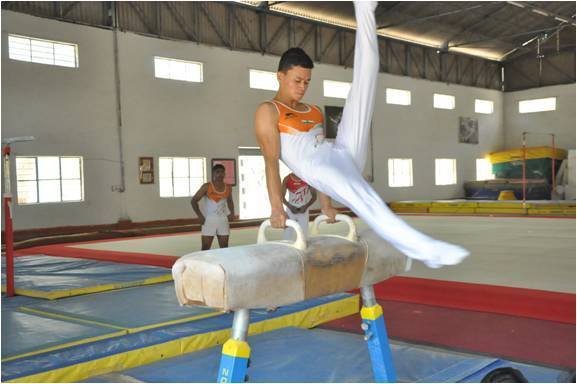Introduction
The Army School of Physical Training is a Category ‘A’ defence training establishment of the Indian Army (Mallick, 2017).
The AIPT is responsible for delivering physical and allied sports training courses for Indian Army personnel, Central Police Organisation, paramilitary forces and personnel from friendly foreign countries.
It also trains instructors to organise and deliver physical training and sports coaching at a level appropriate to individuals and groups at both unit and formation level (ADG PI, 2018).
What is the Army Physical Training Corps?
The Army Physical Training Corps (APTC) has responsibility for physical training in the Indian Army. The AIPT is the spiritual home of the APTC.
The role of the APTC is to:
“…raise, maintain and further improve the standard of physical training, and, to ensure a uniform procedure and method of instructions in physical and recreational training of Army. It further aims at making a soldier fit, both physically and mentally, to play the assigned role efficiently and effectively during war and peace.” (Kumar, 2008).
The APTC was formed on 01 July 1946 “…under the guidance of Lt Col (later Major General) Mohinder Singh Chopra at Ambala.” (Kumar, 2008), and is the smallest corps in the Indian Army.
History of the Army Institute of Physical Training
The history of the Army Institute of Physical Training dates back to 1923.
At the end of World War I (1914-1918), three schools of physical training (PT) were established in India – in Pune, Ambala, and Lucknow respectively. The schools at Pune and Ambala were Command PT schools and the school at Lucknow was a smaller one (Manghnani, 2016; Punekar News, 2016).
In the summer of 1923, the Pune school of PT was closed down and the school of PT at Ambala was renamed the Central Army School of Physical Training (CASPT), becoming the school of PT for the whole of India (Manghnani, 2016; Punekar News, 2016). The CASPT’s summer headquarters was located at Kasauli. Ambala was the headquarters of the Ambala District in the Delhi Division of Punjab Province during the British period. The Ambala Cantonment was established in 1843 after the British abandoned its cantonment at Karnal, following the malaria epidemic of 1841-42.
From 1923 to 1940, British students were trained at both Ambala and Kasauli, but only Indian students at Ambala. From 1940 onwards, Indian students could also attend courses at Kasauli (Manghnani, 2016; Punekar News, 2016).
After partition in 1947, the CASPT moved from Ambala to Wanoworie, Pune. In January 1951, it moved again, this time to Eve’s Estate (Manghnani, 2016; Punekar News, 2016).
The National Gymnastics Coaching camp for the 1964 Tokyo Olympics was held at CASPT and the entire six-member national team which participated in these games comprised Army personnel (Dalvi, 2018).
Initially, the CASPT only offered sports training courses in boxing and athletics, although this has since expanded to include a wide variety of sporting disciplines including:
- Boxing;
- Athletics;
- Basketball;
- Volleyball;
- Yoga;
- Karate; and
- Swimming and lifesaving.
- Refereeing and judging courses.
Alongside the expansion of courses, the CASPT witnessed an improvement in both sports and PT infrastructure.
In 2004, the Army Gymnastics Node was established at CASPT training gymnasts from five gymnastic disciplines (Manghnani, 2016; Punekar News, 2016):
- Artistic;
- Aerobic;
- Acrobatic;
- Tumbling;
- Trampoline.
The AIPT has, over the years, also trained personnel from the Indian Navy, Indian Air Force, Para Military Forces, Central Police Organisations, and State Police Forces.
On 01 June 2005, the CASPT was renamed the Army Institute of Physical Training (Manghnani, 2016; Punekar News, 2016).
Sometime after August 2011, Parag Mhetre introduced Kettlebell training to the Indian Army via the AIPT. Parag Mhetre is the founder of Energy Kettlebell Fitness Academy (EKFA) (EFKA, 2010).
In 2015, gymnasts across all disciplines less artistic were shifted to different Regimental Centres (Punekar News, 2016). The current focus of the Army Gymnastics Node now is to solely concentrate on artistic gymnastics that forms part of Olympic events & World Championships (Punekar News, 2016).
In 2015, training courses in Yoga were established at AIPT (Press Information Bureau, 2015).
What Courses does the Army Institute of Physical Training Offer?
Courses delivered by the AIPT include (BPRD, 2017):
- Assistant Instructors Basic Course (AIBC).
- Swimming & Life Saving Course.
- Boxing Instructor Course.
- Basket Ball Coaching Course.
- Volley Ball Coaching Course.
- Judo & Karate Course.
- Refereeing and Judging courses.
- Officers Physical Training Course (OPTC) (Times of India, 2017):
- An 8-week course for Physical Training Officers (PTOs) who are subsequently posted to various regimental centres and training installations.
- Usually six courses per year, but a shortage of officers had cut that to three per year in 2017.
- Yoga Course:
- An 8-week course delivered three times per year (Press Information Bureau, 2015).
Commandant AIPT
The AIPT is led by the Commandant, an OF-? level officer.
The full title is Commandant Army Institute of Physical Training and Army Physical Training Corps Depot (Commandant AIPT & APTC Depot) (Search Education Portal, 2014).
The Commandant is assisted by a Deputy Commandant.
Where is the Army Institute of Physical Training Located?
The AIPT is located in Chushul Lines on Pune Sholapur Road, Pune in Maharashtra.
The Indian Army has a big presence in and around Pune, with a number of training establishments, including (Frontline, 2010):
- National Defence Academy (NDA);
- Defence Institute of Advanced Technology (DIAT);
- Armed Forces Medical College (AFMC);
- College of Military Engineering (CME); and
- Army Institute of Technology (AIT).
General Staff II and the AIPT
General Staff – II (D(GS-II)) is responsible for “Establishment matters of Army Education Corps (AEC) and Army Physical Training Corps (APTC).” (DOD, 2018).




You must be logged in to post a comment.